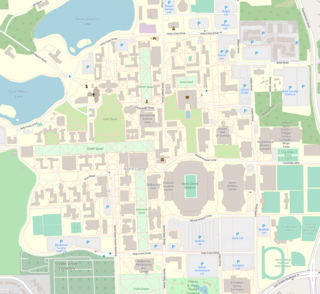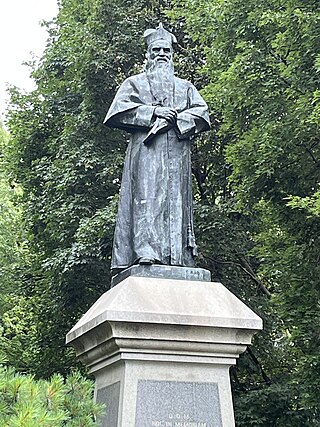
The University of Notre Dame du Lac is a private Catholic research university in Notre Dame, Indiana, United States. Founded in 1842 by members of the Congregation of Holy Cross, a Catholic religious order of priests and brothers, the main campus of 1,261 acres has a suburban setting and contains landmarks such as the Golden Dome main building, Sacred Heart basilica, the Grotto of Our Lady of Lourdes, the 134 foot tall Word of Life mosaic mural, and Notre Dame Stadium.

Theodore Martin Hesburgh, CSC was an American Catholic priest and academic who was a member of the Congregation of Holy Cross. He was president of the University of Notre Dame for 35 years from 1952 to 1987.

The Congregation of Holy Cross, abbreviated CSC, is a Catholic clerical religious congregation of pontifical right for men founded in 1837 by Basil Moreau, in Le Mans, France.

Edward Frederick Sorin, C.S.C. was a French-born priest of the Congregation of Holy Cross and the founder of the University of Notre Dame in Indiana and of St. Edward's University in Austin, Texas.

Rev. John Ignatius Jenkins, C.S.C. is an American Catholic priest of the Congregation of Holy Cross. He is best known for his service as the 17th president of the University of Notre Dame from 2005 to 2024. He previously served as its vice-president and associate provost. He replaced Edward Malloy as president.

The Basilica of the Sacred Heart in Notre Dame, Indiana, is a Catholic church on the campus of the University of Notre Dame, also serving as the mother church of the Congregation of Holy Cross (C.S.C.) in the United States. The neo-gothic church has 44 large stained glass windows and murals completed over a 17-year period by the Vatican painter Luigi Gregori. The basilica bell tower is 230 feet (70 m) high, making it the tallest university chapel in America. It is a contributing building in Notre Dame's historic district listed on the National Register of Historic Places. The basilica is a major tourist attraction in Northern Indiana, and is visited annually by more than 100,000 tourists.
Ave Maria Press is a Catholic publishing company which was founded on May 1, 1865, by Father Edward Sorin, a Holy Cross priest who had founded the University of Notre Dame.
Rev. Edward Aloysius Malloy, C.S.C. is an American Catholic priest, academic, and former college basketball player who is a member of the Congregation of Holy Cross. Nicknamed “Monk Malloy”, he is best known for his service as the 16th president of the University of Notre Dame from 1987 to 2005.
The Rev. John Joseph Cavanaugh, C.S.C., was an American Roman Catholic priest of the Congregation of Holy Cross, served from 1946 to 1952 as the 14th president of the University of Notre Dame, having previously served as its vice president since 1941.

Sorin Hall, nicknamed Sorin College, is the oldest of the 32 residence halls on the campus of the University of Notre Dame and one of the 17 male dorms. It is named after Fr. Edward Sorin, C.S.C., the founder of Notre Dame. Sorin is located directly north of Walsh Hall and is directly south of the Basilica of the Sacred Heart. Sorin houses 143 undergraduate students. Sorin Hall is, along with other buildings on the Main Quad of Notre Dame, on the National Register of Historic Places. Sorin Hall was the first Notre Dame residential hall established as such, although St. Edward's Hall is housed in an older building.

Walsh Hall is one of the 32 Residence Halls on the campus of the University of Notre Dame. Walsh is located on Main ("God") Quad, directly south of Sorin Hall and is directly north of the Knights of Columbus Building. It was built in 1909 and the architect was William J. Brinkmann. Among other buildings on the Main Quad of Notre Dame, Walsh Hall is on the National Register of Historic Places. The coat of arms is taken from the Walsh family.

Badin Hall is one of the 32 Residence Halls on the campus of the University of Notre Dame and one of the 14 female dorms. The smallest residence hall on campus, it is located on South Quad, between Howard Hall and the Coleman-Morse center. It was built in 1897 and hosted the Manual Labor School until 1917 before being converted into a men's dorm. During World War II, it was part of the United States Naval Reserve Midshipmen's School, and in 1972 it became one of the first two residence halls at Notre Dame to host women.
There are currently 32 undergraduate residence halls at the University of Notre Dame, including 31 active residence halls and Zahm Hall, which serves as a transition dorm when residence halls undergo construction. Several of the halls are historic buildings which are listed on the National Register of Historic Places. Each residence hall is single-sex, with 17 all-male residence halls and 15 all-female residence halls. Notre Dame residence halls feature a mixed residential college and house system, where residence halls are the center of the student life and some academic teaching; most students stay at the same hall for most of their undergraduate studies. Each hall has its own traditions, events, mascot, sports teams, shield, motto, and dorm pride. The university also hosts Old College, an undergraduate residence for students preparing for the priesthood.

The University of Notre Dame was founded on November 26, 1842, by Father Edward Sorin, CSC, who was also its first president, as an all-male institution on land donated by the Bishop of Vincennes. Today, many Holy Cross priests continue to work for the university, including as its president. Notre Dame rose to national prominence in the early 1900s for its Fighting Irish football team, especially under the guidance of the legendary coach Knute Rockne. Major improvements to the university occurred during the administration of Rev. Theodore Hesburgh between 1952 and 1987 as Hesburgh's administration greatly increased the university's resources, academic programs, and reputation and first enrolled women undergraduates in 1972.

The campus of the University of Notre Dame is located in Notre Dame, Indiana, and spans 1,250 acres (510 ha) comprising around 190 buildings. The campus is consistently ranked and admired as one of the most beautiful university campuses in the United States and around the world. It is particularly noted for the Golden Dome, the Basilica and its stained glass windows, the quads and the greenery, the Grotto, Touchdown Jesus, its collegiate Gothic architecture, and its statues and museums. Notre Dame is a major tourist attraction in northern Indiana; in the 2015–2016 academic year, more than 1.8 million visitors, almost half of whom were from outside of St. Joseph County, visited the campus.

The Rev. Matthew J. Walsh, C.S.C. was an American priest and President of the University of Notre Dame from 1922 to 1928, after having served has Vice President 1912–22.

The Rev. Andrew Morrissey, C.S.C. was an Irish-American priest and President of the University of Notre Dame from 1893 to 1905, after having served previously as director of studies. He was born in 1860 in Ireland, and left for America at the age of twelve. He studied in the United States and was professed with the Congregation of Holy Cross in 1880. He taught at Sacred Heart College, Watertown, Wisconsin, and was ordained priest in 1884. Morrissey Hall at the University of Notre Dame was dedicated in his honor.

A statue of Edward Sorin, sometimes called Edward F. Sorin, is an outdoor sculpture by Italian sculptor Ernesto Biondi. It is located on the campus of the University of Notre Dame near South Bend, Indiana. The eight foot tall statue depicting the founder of Notre Dame is placed on the main quadrangle of the University near the Main Building. The statue, made of bronze, was unveiled on its campus on May 3, 1906.

The coat of arms of the University of Notre Dame is the assumed heraldic achievement of the University of Notre Dame. It was designed by noted American heraldist Pierre de Chaignon la Rose in 1931.

Robert Alfred Dowd, C.S.C. is an American Catholic priest of the Congregation of Holy Cross currently serving as president of the University of Notre Dame in Indiana.
















